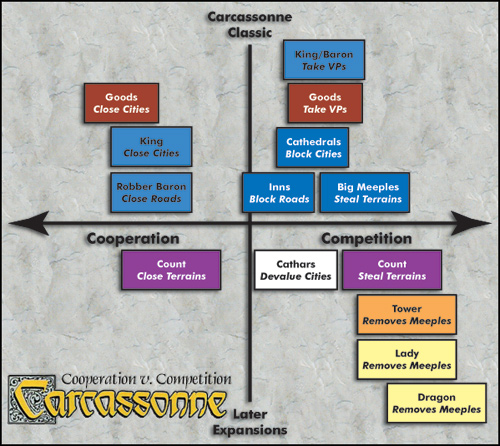 This is my third article on the game system of Carcassonne. In case you missed the others, the first article looked at the game design of the core game and the second article look at how the early supplements affected balance and tile distribution.
This is my third article on the game system of Carcassonne. In case you missed the others, the first article looked at the game design of the core game and the second article look at how the early supplements affected balance and tile distribution.With that out of the way, onward!
I picked up a copy of Carcassonne: The River II in March, and it was the first Carcassonne supplement that I'd bought in some time, due to a variety of factors.
One factor, that's beyond the scope of this series of articles, was that The Cathars was released exclusively through a German magazine. Because I didn't want to spend outrageous amounts of money for four tiles I ended up with a gap in my Carcassonne collection, and thus some of the symptoms of The Collector Bug abated.
A second factor was that I'd had an entirely bad experience with The Count of Carcassonne. I bought it immediately upon release, as I had every Carcassonne supplement to that point, and then when I read the rules I was boggled by the damage it did to the basic non-confrontational Carcassonne gameplay. To this day it's never been played.
The third factor was that I actually ended up removing the previous supplement King & Scout from my mega-Carcassonne box because the additional complexity of the two majority-control tiles from that set (the King and the Robber) were enough to make my eyes roll back in my head, and generally decreased my Carcassonne enjoyment.
This article is the first of two in this series where I'm going to talk about this "dark evolution" of Carcassonne in recent years. Some people might like Carcassonne's new post-2003 direction, but it's definitely very different from what we saw in 2000-2003. This week's article is going to cover that issue cooperation v. competition which first popped up in The Count of Carcassonne and in the next article in this series I'll hit the issue of complexity that started to be an issue for me with King & Scout.
Cooperation & Competition
The original Carcassonne treaded a fine a line between cooperation and competition. Clearly, you wanted to win the game, but at the same time you could form temporary and informal alliances with other players in order to jointly gain points in relation to other opponents. This is one of the aspects that I think really works in Carcassonne, and it's also one of the reasons that I think Carcassonne works best as a three-player game. (That provides enough players for these dynamic alliances to work, but few enough to keep the chaos out of the game that ramps up as does the player number.)
Classic Carcassonne: I think that Klaus-Jurgen Wrede agrees with the value of cooperation, because the classic Carcassonne supplements (Inns & Cathedrals, Traders & Builders, and King & Scout) notably increased the reasons for cooperation.
Traders & Builders did this most dramatically by giving reasons to close other people's cities. You got goods & those could be used to score bonus points at end-game. So suddenly you weren't just cooperating to share points with someone, but you were also doing the good deed of finishing up a city, just for the possibility of an end-game reward. King & Scout repeated the exact same trick. Now you could get points for having completed the biggest road and the biggest city.
Granted, these cooperative methods all introduced a longer-term competition, for the goods markers and the king and robber tiles, but that was perfectly staying in tune with the mixture of cooperation and competition enjoyed by the original game: cooperation in the short-term for the hope of long-term gain.
Along the way there were some minor competitive elements added. The big meeples of Inns & Cathedrals which you could use to entirely steal someone's terrain was definitely the biggest. In addition, as noted in my last article, the cathedrals (and less frequently the inns) or Inns & Cathedrals can be used for blocking purposes, to deny people points in the end-game.
But on the whole those first supplements made Carcassonne feel more friendly and cohesive.
The Later Exansions: The more recent supplements have dramatically changed this, and each new expansion just seems to add to the aggressive nature of noveau-Carcassonne, a nature that I generally find antithetical to the original game's design.
The Count of Carcassonne starts off safely enough, with your getting to place meeples in the 12-tile city of Carcassonne if you close someone else's terrain without scoring points yourself. That's the same cooperative method used for each of the earlier supplements. However whenever a terrain is closed, players can move their meeples to that closing terrain to try and take it over, creating the most direct token conflict yet seen in the game.
The Cathars allows placement of siege tiles simply to spoil other peoples' cities.
The Princess & The Dragon allows you to directly attack (and remove) other players' meeples with princess tiles and the dragon token.
And The Tower provides yet another method to remove meeples, here with towers.
On BoardGameGeek recently I saw the suggestion that people should buy two copies of Carcassonne, placing Inns & Cathedrals and Traders & Builders in one, and The Princess & The Dragon and The Tower in another. Spice with the appropriate mini-supplements as you see fit. King & Scout would clearly go in the first set, The Count of Carcassonne and The Cathars in the second, and The River(s) in whichever you prefer.
I'd have to agree, because the most recent expansions betray the cooperative nature of the original game, while contrariwise, players weaned on the aggressive clashing of the more recent sets would probably be disappointed by the kinder, gentler earlier releases.
Beyond that I have to question the wiseness of such a drastic change in the feel of the gameplay a few years in. I'm sure I'm not the only disappointed player who's going to carefully question every release from here on out (though as I'll discuss in the next article, I've come up with a potential method to this apparent madness).
The following chart summarizes the competive & cooperative nature of the Carcassonne supplements.

A Question of Theme
Though The Cathars and The Count of Carcassonne played around with the idea, The Princess & The Dragon was the first major Carcassonne supplement to upset the cooperation-competition balance of the original game. It also made another major change: it dramatically shifted the theme of the game.
To that date every supplement for Carcassonne has been lightly historical. In 2004 the franchise seemed to embrace its historical background even more, by putting out the very authentic Cathar supplement. Then 2005 came out and we suddenly had a supplement full of fairies, dragons, and magic gates.
I said at the start of this article that there were three things that contributed to my not buying any Carcassonne for a few years: the exclusivity of The Cathars, the competition of The Count, and the combined complexity that appeared when King & Scout came out. But, I'm actually quite weak when it comes to collecting, and even though I'd been disappointed three supplements in a row, for various reasons, I would still have bought The Princess & The Dragon ... if it weren't for the theme.
I don't think talking about the theming of the Carcassonne supplements is nearly as interesting as some of the other topics I've been discussing in this series, but it's still worth this brief note: changing your theme can turn some customers off.
Conclusion
With the advent of The Count of Carcassonne, the Carcassonne franchise saw a sea change. We already saw last week that tile distributions started to devolve and that balance starting to wildly skew. Perhaps more important, however, was the fact that Carcassonne was turned into a very confrontational game, quite far from its original family roots.
In my next article in this series I'm going to finish up my survey of the Carcassonne expansions by asking, "What have we wrought?", and looking at the multiplicative complexity of the Carcassonne expansion system. I'll also end on a positive note by talking about how nice the new River II is and how well it shows off the evolutionary process of a game.
5 comments:
Another excellent article. My thoughts about Carcassonne and its expansions are pretty much in line with yours. We purchased The Princess and the Dragon, but only played with it a couple of times. Now, no one wants to play it again. We especially enjoy the Inns & Cathedrals and the Traders & Builders expansions. We weren't enamored with the King & Scout expansion, because we gave the King and Robber Baron bonuses to the person who "owned" the road or city, not to the person who "completed" the road or city. We may give that expansion another try. We were interested in The Tower expansion when it was first announced, but after learning more about it, we decided not to purchase it -- too much like The Princess and the Dragon, as far as confrontation issues. The Count never appealed to us, and we didn't even give it serious consideration.
I'm looking forward to your comments about River II. After the last several expansions, we have become very skeptical about further ones.
I have only played Princess and the Dragon once and I hated it, so I can understand where you are coming from.
It forces you from long term thinking to "bowb your buddy" to get immediate points.
Needless to say, I am relieved I never bought Princess & the Dragon.
Just wandered into your site but I love your analysis of this, one of our favourite games. I think probably one of the better options for King and Scout is to use the additional tiles without using the additional King/Scout rules...
That's what I do nowadays.
Hi all, I'm a newbye!
I'm reading all your articles and I agree with your analysis. But I think that "The Cathars" is not too bad, it introduces just a little spicy competition and a few more strategy with only 4 tiles, not increasing playing time too much. And I wanna see the face of the owner of a big city with a cathedral near to be closed when he has a sieged tile in the hand! ^_^
Post a Comment